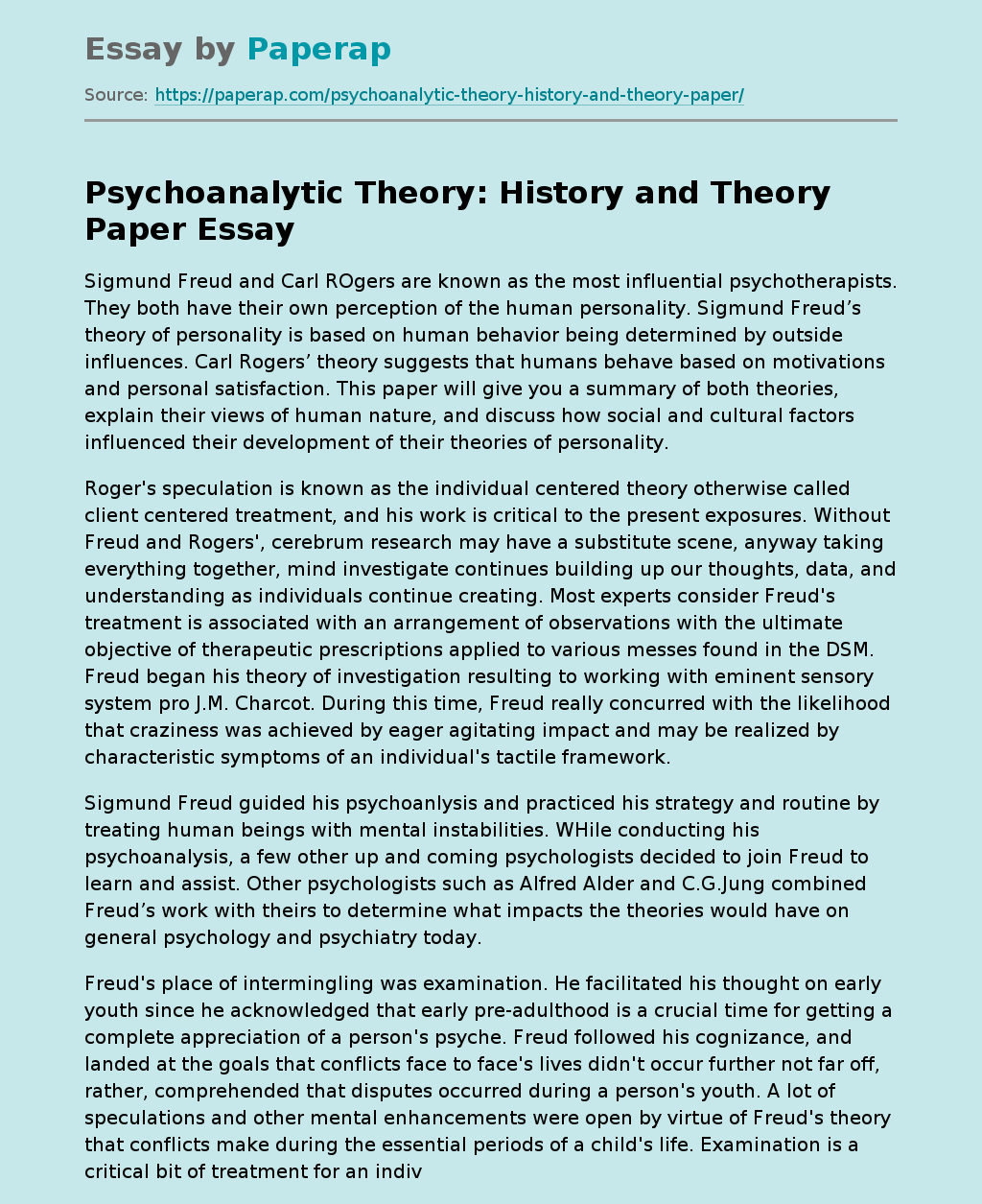Psychoanalytic Theory: History and Theory Paper
Sigmund Freud and Carl ROgers are known as the most influential psychotherapists. They both have their own perception of the human personality. Sigmund Freud’s theory of personality is based on human behavior being determined by outside influences. Carl Rogers’ theory suggests that humans behave based on motivations and personal satisfaction. This paper will give you a summary of both theories, explain their views of human nature, and discuss how social and cultural factors influenced their development of their theories of personality.
Roger’s speculation is known as the individual centered theory otherwise called client centered treatment, and his work is critical to the present exposures. Without Freud and Rogers’, cerebrum research may have a substitute scene, anyway taking everything together, mind investigate continues building up our thoughts, data, and understanding as individuals continue creating. Most experts consider Freud’s treatment is associated with an arrangement of observations with the ultimate objective of therapeutic prescriptions applied to various messes found in the DSM.
Freud began his theory of investigation resulting to working with eminent sensory system pro J.M. Charcot. During this time, Freud really concurred with the likelihood that craziness was achieved by eager agitating impact and may be realized by characteristic symptoms of an individual’s tactile framework.
Sigmund Freud guided his psychoanlysis and practiced his strategy and routine by treating human beings with mental instabilities. WHile conducting his psychoanalysis, a few other up and coming psychologists decided to join Freud to learn and assist. Other psychologists such as Alfred Alder and C.
G.Jung combined Freud’s work with theirs to determine what impacts the theories would have on general psychology and psychiatry today.
Freud’s place of intermingling was examination. He facilitated his thought on early youth since he acknowledged that early pre-adulthood is a crucial time for getting a complete appreciation of a person’s psyche. Freud followed his cognizance, and landed at the goals that conflicts face to face’s lives didn’t occur further not far off, rather, comprehended that disputes occurred during a person’s youth. A lot of speculations and other mental enhancements were open by virtue of Freud’s theory that conflicts make during the essential periods of a child’s life. Examination is a critical bit of treatment for an individual regardless, it is vital to far away a patient tolerating treatment and the master dealing with the psychoanalytic treatment.
In the adolescent stages, the research and knowledge of adolescent psychology has increased overtime. Psychologists are now focusing on current actions throughout a period of time and recent progression during adolescence. Nowadays, therapy is used for the progression of psychology, however, it is losing its ability and is needing improvements. Carl Rogers’ theory created and developed psychotherapy. Although Carl ROgers respected Sigmund Freud, he did not agree with Freud’s theory that conflict surfaces only during the adolescent time period.
Rogers furthermore repudiated that people would create and get self-acknowledgment during a person’s lifetime (Cervone& Pervin, 2010). Rogers believed that Freud’s theory was not psychotherapy but that it was elicit for the individual. A tie between a psychotherapist and a client also known as a client-centered relationship. In spite of the way that this technique was outstanding, Rogers had a substitute view. Rogers believed it to be a therapeutic relationship.
During the therapeutic relationship, the client is not the only one doing all of the talking. The expert is doing the bantering with the client. Rogers was excited about referring to his patients as clients. Rogers felt this would allow the client to perceive that the individual being referred to was not tired of some characteristic ailment. Rogers’ individual centered practice was a significantly seen treatment practice is up ’til now used today for treating people.
Treatment and individual centered theories have a strong impact in cerebrum science today, and will continue having an impact for an extensive period of time to come. Speculations Freud made during his employment continue to rise and never-endingly changing the way in which people see mind inquire about years sometime later. Sigmund Freud’s conjecture not only changed the structure of mind but additionally changed how psychologists see their group and influencing society. SIgmund Freud believed that conflicts are adolescent issues and is able to grow and mature during the adolescent period. However Carl Rogers acknowledged that people continue creating through life as we create.
The study of the brain has been developing for a long time. It will also continue to change and advance into investigation of point by point hypotheses, questions, and answers. Freud didn’t acknowledge that people continued getting data as they grow, rather that pre-adulthood was the time that was basic to the mind. In any case, Rogers envisioned that people create and gain data cause them to acknowledge as they create and continue getting all through life as opposed to simply during youth. Rogers likewise imagined that every individual is one, and acquires their own singularity (Cooper and McLeod, 2011).
As life goes on, we as people will continue to developm, learning from past and present experiences. With this, a person will learn how to improve and mature as a human being. Carl Rogers’ client-centered treatment has continued to teach other people that there are compelling points of view, thinking that people are admirable. Sigmund Freud perceived that it is important to direct patients to seek treatment immediately. Freud classified his patients as patients while Rogers classified his patients as clients. Individuals are in excess of a body in time. They are containers that record what occurs during that time.
Psychoanalytic Theory: History and Theory Paper. (2021, Dec 14). Retrieved from https://paperap.com/psychoanalytic-theory-history-and-theory-paper/

